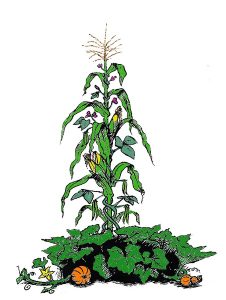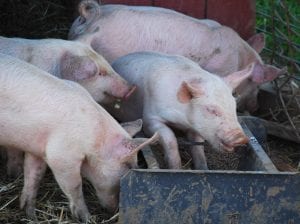If you’ve ever been on a road trip across the United States, you might remember thinking “are we there yet?” while staring into the endless fields of corn, soy, and wheat. Beyond what meets the eye, this landscape represents an agricultural practice called monocropping, or intensively planting a field with one type of crop. Not only is it monotonous, but it also degrades soils, reduces biodiversity and pollinator habitat, and encourages the spread of pests and disease.
In this blog, we take a brief look into the history of human agricultural practices and its impact on food systems today.

From Hunter Gatherers to Farmers
It wasn’t always the case that humans were overconsuming and depleting resources from environment. Prior to the emergence of agriculture around 12,000 years ago, most people lived as hunter-gatherers and relied on understanding seasonal changes to predict when and where food could be found. The earliest transition from hunter-gathering to agricultural societies happened in different parts of the globe including northern China, Central America and the Fertile Crescent in the Middle East. There was no sole factor in driving the shift to cultivating crops, but it likely occurred due to changes in climate, growing population density, and overhunting.
Indigenous Agriculture: The Early Agriculture in the Americas
In the past, Indigenous cultures in the Americas used sustainable farming methods to cultivate the land and support their growing population.
Indigenous Agricultural Practices
People in the Andes and Mexico domesticated many crops we know today, such as squash, beans, tomatoes and avocados. Working with the natural features of an environment, they used agroforestry, permaculture, polyculture and water management techniques to grow crops without degrading the soil. These practices are less harmful to the environment, resulting in better long-term ecosystem health.
In South America, the Amazon rainforest was home to a large number of Indigenous people who lived there for many generations before the arrival of colonists from Europe. An estimated 8 to 10 million people lived in the Amazon region before 1492, clearing land for agriculture and managing it in a sustainable way. These communities adapted to work with the land over time, placing an emphasis on growing edible trees and staple root/seed crops while expanding the genetic diversity of crops. Unfortunately, most of the population died off due to exposure to European infectious diseases, such as smallpox, which may have resulted in their return to hunter-gatherer lifestyles.
Wampanoag Agriculture
 In 17th century New England, the Wampanoag people famously saved the Pilgrims from starvation by sharing their knowledge of how to sustainably use natural resources and cultivate the land. A keystone native agriculture practice was using the “three sisters” crops, or ‘milpa’—corn, beans and squash. This is a form of intercropping, also known as companion planting, where each plant has a role in nourishing the other. Beans provide nitrogen to the soil and corn provides a trellis for beans to grow while the squash “mulches” the area. This creates more diversity in the soil microbiome, leading to better soil health, increased crop yields, natural pest management, reduced weeds and disease, and crop stability over time.
In 17th century New England, the Wampanoag people famously saved the Pilgrims from starvation by sharing their knowledge of how to sustainably use natural resources and cultivate the land. A keystone native agriculture practice was using the “three sisters” crops, or ‘milpa’—corn, beans and squash. This is a form of intercropping, also known as companion planting, where each plant has a role in nourishing the other. Beans provide nitrogen to the soil and corn provides a trellis for beans to grow while the squash “mulches” the area. This creates more diversity in the soil microbiome, leading to better soil health, increased crop yields, natural pest management, reduced weeds and disease, and crop stability over time.
Agriculture Intensifies
As time and technology progressed, advancing agriculture practices resulted in longer lifespans, more permanent settlements and communities, and intensification of clearing land to grow crops. It provided more calories per acre and a steady supply of food, which gave people more free time to pursue activities of leisure and other roles in society. The influence of colonizers on indigenous people also resulted in agricultural shifts, forcing the production of monoculture cash crops, exploiting human rights, and increasing globalization of food systems.
Monocropping and Post WW2 Agriculture
Monocropping became prevalent on a large scale after World War II, and now accounts for most of our food production, as well as non-food crops such as cotton. The practice took off in developing economies during the Green Revolution from the 1960s to 1980s to address hunger with increased food production, as global population growth soared. Unfortunately, the effects on the environment and socioeconomic disparities were unforeseen as the movement also led to the intensive use of synthetic fertilizers and pesticides, which can deplete nutrients from the soil over time and cause harmful runoff that pollutes ecosystems.
Large-Scale Agriculture: The Challenges and Impacts on Modern Food Systems
A hundred years ago, nearly one-third of the U.S. population was involved in farming and there were 6.5 million farms in the country. By the 1970s, many of these smaller farms were taken over by large commercial farms and the average farm size had more than doubled. Today there are 1.9 million farms, and farmers account for only 1 percent of the population. That’s because so much of our farming has been mechanized and large-scale farms produce most of our food.
The current state of our food systems is fragile in the face of a growing population. Large-scale agribusinesses help to meet the world’s food needs, but also contribute to deforestation and soil degradation through tilling, monocropping, and chemical use. Affluent communities frequently have access to fresh food, while many poor and minority communities have been cut off from access to healthy food sources.
 Here in the U.S., people are increasingly disconnected from their sources of food and lack a basic understanding of agricultural products’ life cycles as they travel through different hands and places. Grocery stores provide access to global foods all year round, which disconnects us from concepts of eating seasonally and understanding food systems. One study even found that 41% of youth aged 4-7 believed that bacon comes from plants.
Here in the U.S., people are increasingly disconnected from their sources of food and lack a basic understanding of agricultural products’ life cycles as they travel through different hands and places. Grocery stores provide access to global foods all year round, which disconnects us from concepts of eating seasonally and understanding food systems. One study even found that 41% of youth aged 4-7 believed that bacon comes from plants.
The level of engagement we play in cultivating food from the farm to table can influence our wellbeing through both physical and emotional factors—eating fresh and healthy food while being involved in aspects of community that work together on the land. It is also an opportunity to address awareness and education among youth for environmentally conscious diets.
The Future of Agriculture
Seventy years after the first “Green Revolution” many are calling for another agricultural revolution, but this time, increasing access to food while reducing carbon emissions and building back the health of soils. The recent rise of regenerative agriculture has gained popularity in the media, but these practices actually have ancient roots in indigenous wisdom. Crop rotation, companion planting, agroforestry and water collection are all key practices that indigenous communities around the world used to steward their ecosystems. The solution to many of our current and future agricultural pressures lies in addressing soil health, and this can be vastly improved by honoring and returning to these practices from indigenous knowledge.
Image credits: Iowa farm (Lynn Betts / Photo courtesy of USDA Natural Resources Conservation Service); Three sisters crops (Garlan Miles, CC BY-SA 4.0, via Wikimedia Commons); Pigs (Pig-palooza by Adam Fagen is licensed under CC BY-NC-SA 2.0)


